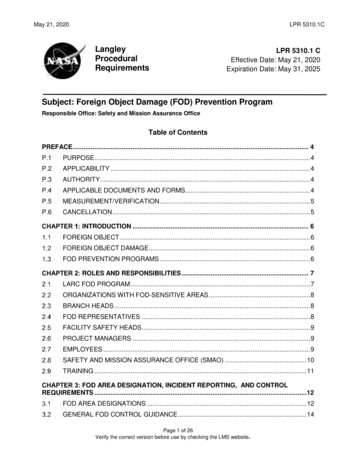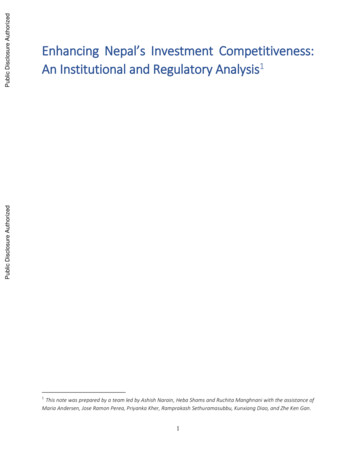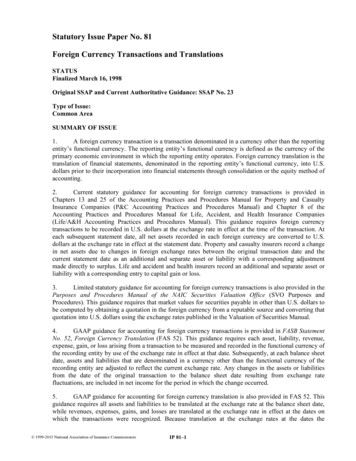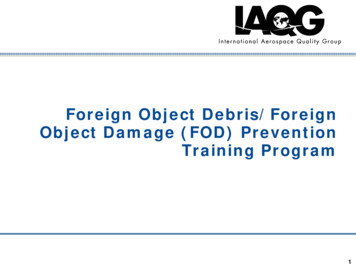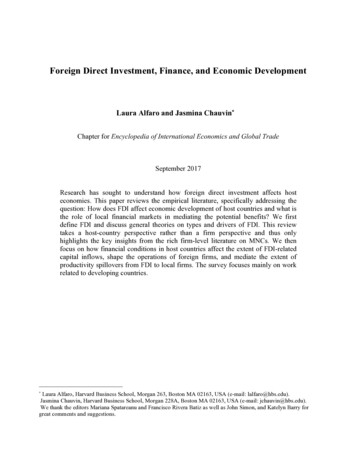
Transcription
Foreign Direct Investment, Finance, and Economic DevelopmentLaura Alfaro and Jasmina Chauvin Chapter for Encyclopedia of International Economics and Global TradeSeptember 2017Research has sought to understand how foreign direct investment affects hosteconomies. This paper reviews the empirical literature, specifically addressing thequestion: How does FDI affect economic development of host countries and what isthe role of local financial markets in mediating the potential benefits? We firstdefine FDI and discuss general theories on types and drivers of FDI. This reviewtakes a host-country perspective rather than a firm perspective and thus onlyhighlights the key insights from the rich firm-level literature on MNCs. We thenfocus on how financial conditions in host countries affect the extent of FDI-relatedcapital inflows, shape the operations of foreign firms, and mediate the extent ofproductivity spillovers from FDI to local firms. The survey focuses mainly on workrelated to developing countries. Laura Alfaro, Harvard Business School, Morgan 263, Boston MA 02163, USA (e-mail: lalfaro@hbs.edu).Jasmina Chauvin, Harvard Business School, Morgan 228A, Boston MA 02163, USA (e-mail: jchauvin@hbs.edu).We thank the editors Mariana Spatareanu and Francisco Rivera Batiz as well as John Simon, and Katelyn Barry forgreat comments and suggestions.
IntroductionIn the early 1990s, cross-border capital flows rose sharply. Their composition also changedin meaningful ways. An increasing share of flows directed towards developing countries (Calvo etal., 1996) largely took the form of foreign direct investment (FDI) rather than portfolio or equityflows. Following the sharp decline in capital flows worldwide precipitated by the global crisis of2007-2008, FDI flows to developing countries rebounded more quickly than other components ofglobal capital flows (Duttagupta et al., 2011) and remain high, at roughly 10 percent of gross fixedcapital formation.1Developing and emerging market economies’ increasing participation in FDI inflows overthe past two decades reflects both push and pull factors (Reinhart & Reinhart, 2008; Forbes &Warnock, 2012; Fratzscher, 2012). On the push side, declining transportation costs, significantdifferences in factor prices, and slowing growth rates in developed countries drove an increasingnumber of firms to establish operations abroad. On the pull side, many governments, seeing FDI askey to bringing the capital, technology, and know-how needed to move their economies fromtraditional activities to higher-end manufacturing and services, not only liberalized flows butactively competed for FDI with a variety of preferential incentives and policies (Harding &Javorcik, 2007).With several decades of activities to assess, we can ask: what has been the effect of FDI ondevelopment in the host economies? In the broadest sense, FDI can affect economic developmentby increasing the availability of factors of production, specifically, capital.2 But FDI can be morethan capital. The possibility that foreign-owned firms can have a positive impact on the localeconomy and on productivity levels of domestic firms is perhaps of even greater importance.Improvements in local productivity due to the presence of foreign companies may arise from anumber of channels. On the macro side, FDI could spawn new economic sectors, push aneconomy’s technological frontier, and diversify exports. On the micro side, through knowledgespillovers and linkages between foreign and domestic firms FDI could foster technology transfer,1Source: UNCTADstat, Foreign direct investment: Inward and outward flows and stock, annual, 1980-2014 Table.Available from View.aspx?ReportId 96740.2Although FDI can be associated with cross-border transfers of factors of production beyond capital (e.g., labor,machinery), capital flows, because they account the bulk of activity, have received the most attention in the literature.Non-capital factor flows associated with FDI are discussed by Burstein & Monge-Naranjo (2009), McGrattan &Prescott (2009), and Ramondo (2014), among others.2
improve managerial and employee skills, and boost investment incentives and productivity inupstream and downstream sectors. Intensifying competition that results from foreign entry couldincentivize local firms to upgrade their productivity, drive out unproductive domestic firms, andreallocate factors of production to more productive firms and uses.Theoretical benefits notwithstanding, empirical studies of the effects of FDI have producedmixed evidence. Lipsey (2004) observes that the overall evidence from macro-level empiricalresearch favors positive effects of foreign presence on wages and the volume and diversity ofdomestic exports, but finds no consistent relationship between the size of inward FDI stocks orflows and GDP or growth. On the micro side, a first generation of cross-sectional studies generallyfound a positive correlation between foreign presence and within-industry productivity, forexample Caves (1974) in Australia and Blomström (1986) and Blomström & Wolff (1994) inMexico. However, controlling for the fact that foreigners selectively enter the most profitable firmsand industries, Aitken & Harrison (1999) show productivity to improve in plants that receive FDIinvestment and decline in domestically owned plants in the same industry, rendering the net effectof FDI on sector productivity quite small. Evidence of positive spillover effects has tended to bemore favorable in vertically related industries (Javorcik, 2004), and more generally in developedcountries.3In light of the foregoing evidence, initial optimism has given way to a more nuanced viewof FDI. There is consensus that the development benefits of FDI are not automatic, but will dependon a number of conditions in a host economy. FDI’s ability to push the knowledge frontier maydepend on a host country’s current level of economic development and education (Borensztein etal., 1998) to introduce new exports and open up markets on existing trade policies and the overallcompetitive environment (Balasubramanyam et al., 1996), and to generate spillovers and cultivatelinkages with other sectors on the strength of local financial markets (Alfaro et al., 2004, 2010).Such complementarities between FDI and other country characteristics help to explain the findingsthat spillovers are greater in developed than in developing countries. This review focuses oncomplementarities between FDI and local financial markets. Specifically, we address thequestion: How does FDI affect economic development of host countries and what is the role oflocal financial markets in mediating the potential benefits?3Based on findings from Görg & Strobl (2002) in Ireland, Haskel et al. (2007) in the United Kingdom, and Keller &Yeaple (2009) in the United States.3
The focus on the FDI-finance-development nexus omits many other aspects of the richmacro literature on FDI including non-finance related determinants of global FDI flows, and theimportant role of host-country institutions and complementarities other than finance.4 Focusing ondevelopment outcomes, this review also omits discussion of developed-to-developed country FDIand home-market effects of FDI. We predominantly take a host-country perspective rather than afirm perspective and thus only highlight the key insights from the rich firm-level literature onMNCs, including motives for international expansion, internal organization, choice of market entrymode, and productivity drivers. Discussion of the link between finance and the developmentbenefits of FDI also excludes consideration of FDI in the financial sector including how it canshape the quality of local financial institutions. 5 Analysis of financial-sector-FDI (such asmultinational banks setting branches or subsidiaries in developing countries) is discussed in detailby Poelhekke (2017) in Chapter 3 of the current volume. Finally, although it raises certain policyimplications, the review does not delve into government policies aimed at attracting FDI, and whatis known about their effects.The rest of this chapter is organized as follows. In Section II, we define FDI and discussgeneral theories on types and drivers of FDI. How financial conditions in host countries affect theextent of FDI-related capital inflows is discussed in Section III; the role of local financialconditions in shaping the subsequent operations of foreign enterprises, including their likelihood toincrease host economy exports, in Section IV; and the role of financial conditions in host countryproductivity through spillovers to local firms and reallocation effects in Section V. Section VIconcludes with a brief discussion of policy implications and directions for future ctInvestment4The vast academic literature on foreign direct investment has been surveyed many times. See Markusen (1995),Blomström & Kokko (1998), Hanson (2001), Alfaro & Rodríguez-Clare (2004), Barba Navaretti et al. (2004), Görg &Greenaway (2004), Lipsey (2004), Moran (2007), Caves (2007), Alfaro et al. (2009), Harrison & Rodríguez-Clare(2010), Yeaple (2013), Foley & Manova (2014), Antràs & Yeaple (2014), Alfaro (2015, 2017), and Alfaro and Chen(2016) for surveys of determinants, effects, spillover channels, and empirical findings.5For reviews of the topic of FDI in the financial sector, see Clarke et al. (2003) and Goldberg (2007).4
International capital flows associated with investments in firms in which a foreign investoracquires a controlling stake are classified as direct investments and those associated with purchasesof stocks or bonds without a controlling stake as portfolio or equity investments.6 That control canbe exercised in many ways and to varying degrees complicates measurement of foreign directinvestment at the macro level. The Organization for Economic Development (OECD),International Monetary Fund (IMF), United Nations Conference on Trade and Development(UNCTAD), and U.S. Department of Commerce, among others, classify a firm as “foreign-owned”if a non-national investor (the “parent”) holds at least 10 percent of the equity of a local firm (the“affiliate”).7 The somewhat arbitrary 10 percent threshold is meant to reflect the notion that largestockholders, even if they do not hold a majority stake, will have a strong say in a company’sdecisions and participate in its management.Total FDI is an account in the national balance of payments that sums up, at the countrylevel, the total value of the affiliate equity, reinvested earnings and net inter-company loansattributable to foreign parents. An FDI flow is a change in FDI, year-to-year. Note that FDI thusdefined obscures some of the interesting variation in the actual activities of foreign firms in a hosteconomy. Specifically, FDI statistics fail to capture the portion of the foreign enterprise financedby local debt or equity. They do, on the other hand, capture components that do not necessarilyinvolve a movement of financial capital across borders in the current period, for example increasesin affiliate reinvested earnings. Increases in inter-company loans will also increase FDI, but there isevidence that MNCs adjust levels of inter-company loans opportunistically on the basis of tax rates(Blouin et al., 2014), in which case such FDI inflows are likely to be driven by financial rather thanoperational considerations. As noted by Hausmann & Fernandez-Arias (2000): “FDI is not the firmand its assets. Instead, it is just one of the sources of financing for the firm.”Therefore, recent research has increasingly analyzed firm-level operational data in order tobetter understand the impact of FDI on host economies. Foreign investment can take place via theconstruction of new production facilities (greenfield investment) or via a merger or acquisition of6Our focus being on firms in the real economy, other components of international capital flows including changes ingovernment reserves and other investments (which predominantly feature flows related to international bankingtransactions) are not central to our discussion.7As stated by OECD (2008, p. 23): “Accordingly, direct investment is considered evident when the direct investorowns directly or indirectly at least 10 percent of the voting power of the direct investment enterprise. In other words,the 10 percent threshold is the criterion to determine whether (or not) an investor has influence over the management ofan enterprise, and, therefore, whether the basis for a direct investment relationship exists or not.” This definition is alsoused by the IMF (2009) and by UNCTAD.5
an existing local company (brownfield investment). In 2007, the value of recorded mergers andacquisitions stood at over 50 percent of total FDI flows, but with some interesting variation acrosscountries (Antràs & Yeaple, 2014). Investment activity between developed economies has tendedto take the form of mergers and acquisitions (M&As), developed-developing country FDI the formof greenfield investment. Although foreign-owned companies can be stand-alone firms, researchhas focused on activities of multinational corporations (MNCs), defined as firms that own andcontrol assets in at least two countries (Caves, 2007). MNCs represent only a small share of allfirms, but account for a significant amount of global economic activity including roughly 90percent of U.S. exports and imports (Bernard et al. 2009).What drives firms to transact across borders? Motivations for FDI vary, but the economicliterature identifies three broad types: horizontal, vertical, and complex.8 Horizontal FDI, whichinvolves establishing abroad an affiliate in a firm’s primary industry to serve customers in theforeign market, is observed when the cost of doing so is less than the cost of producing at homeand shipping to the end market. Vertical FDI, which involves establishing a foreign affiliate thatproduces inputs to or provides intermediate services associated with a final product, is a responseto differences across countries in production costs or availability of specific factors and inputs(e.g., raw materials). The emergent concept of “complex” FDI reflects the increasing sophisticationof global production and distribution chains in which firms’ positioning can be driven by bothhorizontal and vertical motivations.More fundamentally, what accounts for investors’ willingness to acquire foreign firms orbuild new factories abroad rather than rely on arms-length transactions (e.g., with third-partysellers or suppliers)? In the face of added costs of doing business in another country, includingthose incurred for communication and transportation and stationing personnel abroad, barriersassociated with language and customs, and exclusion from local business and government8On horizontal FDI, see Markusen (1984), Brainard (1997), Markusen & Venables (2000), and Helpman et al. (2004),on vertical FDI, Helpman (1984), Yeaple (2003b), and Alfaro & Charlton (2009), and on complex FDI, Yeaple (2003a)and Ekholm et al. (2007). For reviews of the literature, see Antràs & Yeaple (2014). Ramondo et al. (2014) provide anempirical description of types of sales (horizontal, vertical, export-platform) for U.S. foreign affiliates. For a discussionon the role of geography, and the location of FDI see Alfaro and Chen (2014, 2016). For an analysis of integrationchoices along the value chain see Alfaro, Conconi, Fadinger, and Newman (2016) and Alfaro, Antràs, Chor, andConconi (2015).6
networks, how can a foreign firm offset local firms’ advantage and superior knowledge of themarket, legal and political systems, language, and culture?An explanation provided by cost-of-capital theory, which focuses on the availability offinancial capital, is that foreign firms’ size or structure may afford access to low-cost fundsunavailable to local firms. This rationale, which renders multinationals simply arbitrageurs thatmove capital from low return to high-return countries, although it has some explanatory power, isincomplete. If lower cost of capital were the only advantage, why would a foreign investor endurethe headaches of operating a firm in a different political, legal, and cultural environment rather thansimply make a portfolio investment? There is evidence, moreover, that investors that take controlof a foreign company sometimes finance a significant share of the investment in the local market.Finally, FDI flows—particularly among developed countries—have proceeded in both directionsand often in the same industry. As MIT economic historian Charles Kindleberger noted, “Directinvestment may thus be capital movement, but it is more than that.”9Hymer (1976) was among the first to propose the existence of multinational firms to beexplained by real (as opposed to financial) factors. He argued that non-financial assets enableMNCs to compete internationally, for example their ability to exploit market power and limitcompetition across multiple markets. Subsequent work identified additional advantages ofmultinational ownership summarized by Dunning (1981) in the ownership-location-internalization(OLI) framework, which identifies three broad classes of MNC advantages. 10 Ownershipadvantages suggest that MNCs have some firm-specific valuable assets like patents, technology,processes, and managerial and organizational know-how that allow them to overcome the costs ofoperating in another country. They have the opportunity to leverage these across multiple businessunits at little incremental cost and simultaneously deploy them in multiple locations; additionally,the cost of arms-length dealings may favor internalization of global market transactions. Theproductivity advantage such non-financial assets afford over local firms may compensate to somedegree for the impediments to and added cost of operating abroad.These two explanations, MNCs as providers of cross-border capital and owners of valuableassets, together provide a more comprehensive rationale for why they own and operate assets9Kindleberger (1969), p. 3.This includes work by Kindleberger (1969), Caves (1971), Buckley & Casson (1976), and Rugman (1981), amongothers.107
across borders. MNCs’ possession of intangible as well as tangible capital could account for thepotential of FDI to contribute to host country economic growth not only through capital, but alsovia spillover, competition, and productivity effects. The explanations’ degree of relevance can varyfor any given foreign investment. MNCs’ importance as providers of cross-border capital maydominate when, for example, local capital is scarce, as when a financial crisis or currencydepreciation prompts deep-pocketed foreign investors to scramble to acquire undervalued localassets. MNCs that finance a large share of their foreign operations locally, on the other hand, maybe less important as providers of tangible than of intangible capital, such as technology, managerialknow-how, and global market access. These subtleties are elucidated below, the focus on FDI andinflows of tangible capital in Section III, and on the development benefits frequently attributed tointangible capital including MNCs’ higher productivity and spillovers to local firms in Sections IVand e of the most direct ways through which FDI can contribute to economic development isby increasing the amount of capital available in the local economy. In developing countries, inwhich capital is typically scarce relative to labor, policy makers frequently view potential capitalinjection to be the key benefit of FDI because it directly increases investment and gross domesticproduct (GDP) in the host economy.11 FDI thus allows countries to supplement capital provided vialocal savings with capital coming from abroad. However, as the following discussion will show,the extent to which foreign firm activity indeed generates a net increase in capital depends on localfinancial conditions.1211The dearth of flows from rich to poor countries relative to the predictions of neoclassical theory, termed the “Lucasparadox” (Lucas, 1990), has fueled a vast literature in international macroeconomics that seeks to understand thedeterminants of international capital flows (or lack thereof) between rich and poor countries and the consequences foreconomic growth (see Alfaro et al., 2007, 2008, 2014).12Here we focus on host country financial conditions. A rich literature on home country financial conditions finds thatgood conditions generally facilitate, and tight conditions constrain, outward FDI flows. Klein et al. (2002) discuss twoprimary channels at play, a relative wealth (foreign assets appearing relatively cheap when home market conditions, inparticular, exchange rates, are favorable) and a credit access effect (risk capital actually being available). In a crosscountry study using measures of equity- and debt-market strength, di Giovanni (2005) finds home market conditions toexplain roughly 10-15 percent of the variation in the dollar value of bilateral M&A flows, and deep stock markets to bemore important than credit markets.8
Host country financial conditions may have an ambiguous effect on total FDI because theyaffect both whether a foreign investment takes place and whether it is financed through FDI. Onthe one hand, good financial conditions attract investment to a host market in part because theyallow foreign investors to finance for an important share of their investment locally (Kindleberger,1969; Graham & Krugman 1995; Lipsey, 2004). Local financing may be preferable to cross-borderfinancing because it allows investors to hedge the exchange rate risk associated with sales or costdenominated in the local-market currency. On the other hand, precisely because investors are likelyto substitute FDI with local funds, in countries with good financial markets the total value ofcapital that foreign firms bring from aboard may be low. In the data on affiliates of U.S.multinationals, Lehmann et al. (2004) find total host country financing (provided primarily in theform of debt) indeed accounts for a larger share of financing than what is provided by U.S. parents.Beyond lowering the extent of capital inflows, foreign firms borrowing heavily from localbanks may exacerbate domestic firms’ financing constraints by crowding them out of domesticcapital markets. Harrison & McMillan (2003) analyze the behavior of mostly French multinationalsoperating in Côte d’Ivoire, finding not only that domestic firms are more credit-constrained thanforeign firms, but that borrowing by foreign firms exacerbates the credit constraints of domesticfirms. In a country such as Côte d’Ivoire, with numerous market imperfections and with creditaccess rationed due to interest-rate ceilings, the total pool of capital available for local firms did notincrease; rather banks substituted lending to domestic with lending to foreign firms. Harrison,Love, & McMillan (2004) on the other hand show results suggesting that FDI tends to crowd infinance for domestic enterprises across a panel of countries. That is, as foreign investmentincreases, the amount of credit available to domestically owned firms actually rises. These twostudies highlight that the effect of FDI on local credit constraints is heterogeneous across countries,with important complementarities between FDI and preexisting local financial conditions.Foreign firms are less likely to tap into local capital markets in countries where financialconditions are poor and therefore such countries may attract more FDI. Lehmann et al. (2004)indeed find that in developing countries, the financing share from U.S. parents is 45 percent (asopposed to 30 percent in industrial countries), much of it provided in the form of equity. Desai etal. (2004) find that firms substitute for missing or inefficient local debt markets also through theirinternal capital markets, in the form of inter-company loans. They show foreign affiliates of U.S.firms in countries with weak capital markets to offset approximately three-quarters of reductions in9
external borrowing with internal funds from parent companies. Local affiliates are more likely toopportunistically tap into parent firms’ internal resources through inter-company loans when localcredit conditions deteriorate or in times of crisis.13 While this suggests that internal capital marketscan alleviate external financing constraints, limits to multinational firms’ total resources and intrafirm competition for such resources may still restrict the growth of local affiliates inunderdeveloped financial markets and render the size of projects suboptimal, as argued by Feinberg& Phillips (2004).Antràs et al. (2009) highlight a different mechanism through which poor financial marketsmay incentivize FDI – by affecting the firm’s optimal organizational form. They model a world inwhich an inventor has the option of transferring technology internationally via an arms-length(market based) relationship or internally, though FDI. The key result in their model is that when thelocal financial sector, in particular, investor protections, are weak, local funders will insist onforeign equity participation (i.e. FDI) in order to ensure sufficient monitoring and valuemaximization by local entrepreneurs. The authors’ empirical analyses confirm that in countries inwhich credit markets are deeper (as measured by the private credit to GDP ratio) and investorprotections higher, firms are more likely to use arms-length relationships than to establish foreignaffiliates via FDI while parent firms will own a higher share of affiliate equity and finance a greatershare of affiliate assets internally in countries in which financial conditions are weaker.14 Using asimilar theoretical lens, Carluccio & Fally (2012) show that firms are also more likely to integratetheir suppliers when they are located in financially underdeveloped markets, which also leads tomore FDI.15Keeping in mind the theortically ambiguous effect of host market financial development onFDI, Desbordes & Wei (2014) seek to empirically assess its causal impact on greenfield FDI. Thechallenge of such work lies in addressing identification concerns arising from the reverse causalitybetween FDI and financial development as well as omitted variabes that are related to both. Theauthors use an identification strategy that follows Rajan & Zingales (1998), in which identification13Recall that inter-company loans are included in calculations of total FDI.Specifically, they report parent provided financing to average 45 percent of affiliate assets in countries in the lowest,and 38 percent of affiliate assets in countries in the highest, quintile of private credit.15Relatedly, Antràs & Foley (2015) show that the quality of the local institutional environment also affects the choiceof contractual terms in arms-length relationships between multinationals and their suppliers. Transactions are morelikely to occur on cash in advance or letter of credit terms (as opposed to more flexible terms) when the importer islocated in a country with weak contractual enforcement.1410
proceeds from the interaction of industry financial vulnerability and measures of host countryfinancial development, and the effect is theorized to be larger for firms in financially vulnerableindustries. They find that the net effect of host country financial development on the magnitude ofgreenfield FDI is positive, and that the effect primarily operates by increasing the average size(rather than the number) of greenfield projects.A related strand of literature proposes that albeit FDI does bring fresh capital into theeconomy, it reflects, to some extent, arbitrage activity by multinationals. Rather than driven byfundamental productivity arguments, this type of FDI is akin to foreigners opportunisticallypurchasing undervalued local assets (Krugman, 2000; Aguiar & Gopinath, 2005).16 In this case,even if FDI does bring fresh capital, some authors have questioned whether this is indeedbeneficial to the host economy, one of the main concerns being volatility, i.e. sudden movementsof capital in and out of the country. Although crisis-related flows might provide temporary relief,they might not represent a net capital increase in the long run. Baker et al. (2009) seek toempirically disentange real versus arbitrage-driven foreign investment and suggest that arbitrage isabout half as important as fundamentals. Rapid deterioration in host country debt and equitymarkets can precipitate a surge in arbitrage-driven FDI.On the other hand, Razin & Sadka (2007) make the case that foreigners are likely to pay apremium for local assets, in which case the host economy does benefit from a long-term capitalincrease even if FDI flows are opportunistic. In their model, technical or managerial know-howaffords foreign direct investors an advantage over domestic investors in skimming the best projects.Depending on the level of competition among investors, the benefits of this unique advantagemight be shifted to the domestic country through the acquisition price foreign direct investors payfor plum projects. However, the advantage also leads to a “lemons” problem. That is, if an investorneeds to sell a firm, potential buyers might suspect the sale to be motivated by private informationabout its true productivity rather than by a genuine need for liquidity. The local firm may then sellfor less than would otherwise have been the case.1716See also Froot & Stein (1991) and Klein & Rosengren (1994) in the context of capital inflows into the United States.The last two paragraphs relate to a broader discussion of how foreign capital flows affect the rate of return to capital,especially in capital scare countries (see discussion in Alfaro et al. (2007, 2008, 2014). The tradition
the past two decades reflects both push and pull factors (Reinhart & Reinhart, 2008; Forbes & Warnock, 2012; Fratzscher, 2012). . spillovers and linkages between foreign and domestic firms FDI could foster technology transfer, !!!!! 1 Source: UNCTADstat, Foreign direct investment: Inward and outward flows and stock, annual, 1980-2014 Table. .


